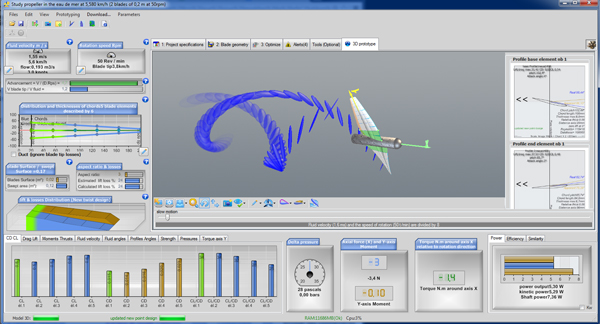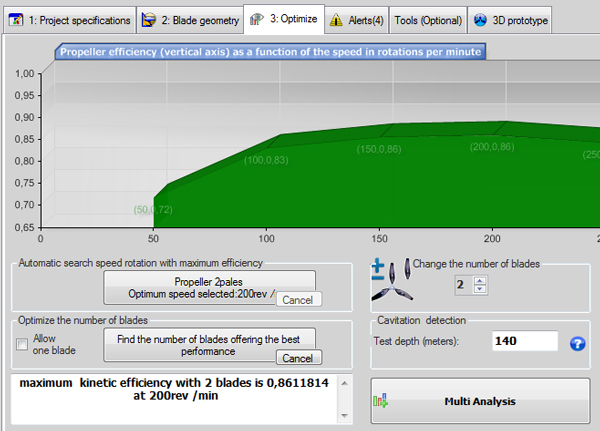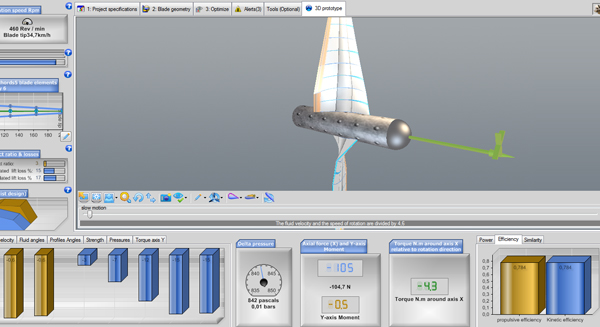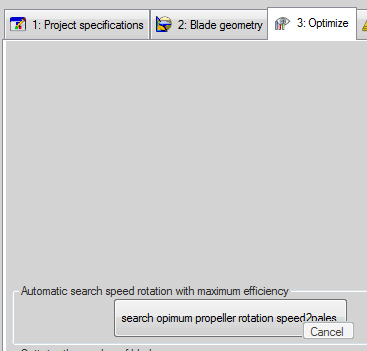Modeling propeller in heliciel software
Tutorial design a boat propeller (3): Construction adjusting the rotation speed and radius at blade root
Understand and master the boat screew propeller design part (3/5): Construction adjusting the rotation speed and radius at blade root:

when we have defined the operating point, we have left the rotation speed, it is time to take care of it...
We could test the propeller rotational speeds, changing this setting and rebuilding, until you find a speed with a good efficiency. But these iterations may be long and tedious. We therefore take this opportunity to discover a new function Heliciel: Optimizing the rotational speed depending on the optimum efficiency.- To do this select the tab:3 Optimize.:
Here we get a kinetic efficiency of 0.86 at 200 rev / min:Click "search optimum propeller rotation speed 2 blades". Heliciel execute the search rotational speed with the maximum kinetic efficiency. (the propulsive efficiency is not a reference in this procedure for propellers with fluid velocities close to 0 the propulsive efficiency would not be significant)

After the search of optimum speed you are asked if you want to rebuild your 3D propeller, click yes .We get our propeller rebuilt with a new twist, suitable for its speed, providing the optimum efficiency:

The propulsive efficiency of our propeller (thrust * velocity) / (torque shaft *speed rotation) is 0.861 is not far from the maximum!
It's not bad but looking more closely the performance results:

- The thrust of our propeller (axial force) is -29 newtons (the negative sign indicates that the force is opposite to the direction of flow)
- The power to the shaft is 51.32 w
We observe that we are far from our specifications:to increase thrust , Several solutions are available to us:How to increase thrust to get our 105 Newtons? We will take this Question to deepen the problem of optimization of the propeller::
- Cruising speed: 3 knots
- Thrust required 105 newtons
- Power available to the propeller shaft: 192 watts
- Increase rotational speed:
simple, just change the speed until the desired thrust. let's try now: increasing the speed until reaching our power available to the shaft: after a few tries speed change and reconstruction, nous obtenons un résultat de 197 watts pour 101.3 newtons de poussée à 360 t/mn avec un rendement de 0.79. It begins approaching our specifications.

- Increase the surface area of the blades: Two methods allow us to increase the surface area of blades::
- Increase the number of blade:
- Advantage: When the diameter should not be increased (it is often the case for vessels must maintain navigability in shallow water) ,it is possible to increase the number of blades to increase the thrust.
- Disadvantage: The weight, complexity and price of the propeller will be increased.
- Increasing the width of the blades:
- Advantage: By increasing the width of the cords of blade profiles we increase the surface lift and reduces the risk of cavitation..
- Disadvantage: The blade tip losses are even lower than the blades are elongated by increasing the width of the blades without increasing the length we increase the proportion of losses at the blade tip.
- Increase the number of blade:
- Increase the number of propellers:
- we could add a contra rotating propeller helice contra rotative:
- Avantage: propeller downstream can straighten the tangential flow, the overall performance of two coupled helices will be better.
- Disadvantage:more complex and more expensive to achieve.
- we could add a contra rotating propeller helice contra rotative:
- Increase the performance of blade profiles:
A search of the optimum profile shapes, requires a comparative performance of different profiles available to our analysis.This solution takes us directly into the heart of HELICIEL, which has been developed to easily find the best profiles in its database ......
next: Tutorial boat propeller design (4)


 Global site map
Global site map Mecaflux
Mecaflux Tutorials Mecaflux Pro3D
Tutorials Mecaflux Pro3D Tutorials Heliciel
Tutorials Heliciel Mecaflux Store
Mecaflux Store Compare software functions
Compare software functions Quotes, Orders, Payment Methods
Quotes, Orders, Payment Methods project technical studies
project technical studies